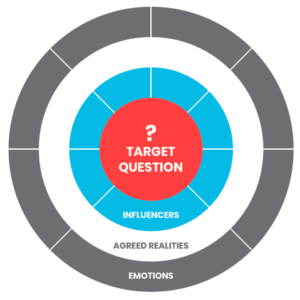HOW TO CREATE POSITIVE NARRATIVES (2/4)
Target audience – define who it is you are talking to
The most important thing to know is that whatever you do or say: “No, you can not reach everyone!”. Put out of your mind the latest viral campaign that the ‘whole world’ has heard of. They are special because they are rare. If you can live with that, get to work and get to know your target audience well. The more specific you are, the better. That will allow you to craft the right message and focus on the most effective channels. This is called a micro target audience (or a hyper segmented audience) you can make an impact on to create behavioural change.
To change a narrative, you should first understand, what is their current one (why are narratives important, read from part 1). And for this you need to understand, WHY do they behave the way they do now? The following will help you get to the core of it.
Start by writing down a simple question you have about a behaviour. Use the formula WHY + COMMUNITY + BEHAVIOUR. E.g Why don’t people with cars use their own coffee mugs in gas stations? The more specific about it you are, the easier will be the next steps. Secondly, examine who influences your chosen target audience. And then analyse the beliefs and the emotional drivers behind the audience’s behaviour.

Try doing that yourself – the referred illustrated chart may be of help. After stating your question, identify up to eight influencers who have an impact to your audience. In this case, people who drive cars are influenced by their partners, peers, car brand, media, etc.
Then identify what are the beliefs they have about their behaviour. This is the hard part. Do not describe the objective reality – but the subjective! How does your target audience think of your chosen topic? Try matching the belief with the chosen influencer. For example, you may be viewing media and be seeing more and more environmentally friendly advertisements – this is your world! But your chosen profile notices that a successful person drives a car, fills a tank in a specific gas station and buys anything they like.
Finally – in each slice of the map you should place a corresponding emotional payoff – what a person gets from this behaviour. Emotions drive people! It is human to always rationalise our behaviour, but the roots to it come from emotion. Why is that important? Because emotions that arise from these beliefs give your target audience a positive feeling. This is a driving force and your task will be to hack into it with a substituting behaviour that should also provoke positive feelings! What would our hypothetical car driver feel? Possibly self-fulfilment, a confirmation of a succesful position in the society.
In the next blog, I will explain, how based on that exercise, you can craft a target audience statement for your particular campaign. The one that states the answer to the WHY question I mentioned in the beginning. If crafting a campaign is a specific skill you want to develop in your team, reach out to our team, our trainers might just be able to craft you a training you need!
Tips: how to get to know your target audience?
Investigate! Beware of stereotypical assumptions and keep an open mind. This is an empathy course on steroids! You cannot claim to be a societal change manager if you cannot overcome your own biases. Interview your target group. Get to know them. What are their likes and dislikes? How do they speak? There are even softwares that help track that. But you can also do a little research by reading comments to related posts or news, joining social groups they are present at or observe them in their ‘natural habitat’.
Be ready to be surprised to learn something new. And most importantly, after you have done all that, you may find that you even understand their view point. Don’t freak out – it is OK. That is actually what you want to happen. It does not mean you have to agree with it.
« Previous post
HOW TO CREATE POSITIVE NARRATIVES (1/4)Next post »
Biodegradable plastics